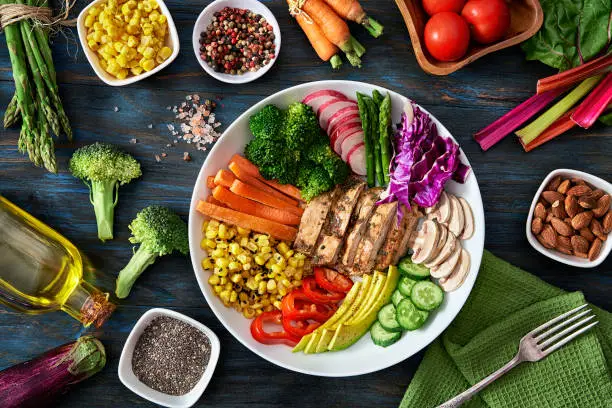We envision a world where everyone has the tools and knowledge to live a balanced, healthy, and fulfilling life. By providing reliable resources, personalized programs, and community support, we aim to be a beacon of hope for those on their health journey.
Table of Contents
Introduction to Processed Foods; Can Fast Food Be Healthy
Processed foods are items that have been altered from their original form for safety, convenience, or shelf stability. This alteration can involve freezing, canning, baking, or dehydrating, but it predominantly includes the addition of preservatives, sweeteners, and flavor enhancers. Fast foods, a subset of processed foods, are often characterized by their speed of preparation and consumption. These foods are typically offered at restaurants or fast-food outlets, providing customers with quick meals that are easily accessible and often inexpensive.
The prevalence of processed and fast foods in modern diets can be attributed to various factors. With our increasingly busy lifestyles, many individuals find themselves with limited time to prepare and cook meals at home. This creates a demand for quick, ready-to-eat options that can be consumed on-the-go. Additionally, the aggressive marketing strategies employed by the fast-food industry have significantly influenced consumer choices, often tempting individuals with appealing advertisements that promote convenience and affordability over health-oriented options.
Nutritional implications linked to the consumption of processed and fast foods are concerning. These items generally contain high levels of unhealthy fats, sugars, and sodium, which can contribute to numerous health issues, including obesity, heart disease, and diabetes. Moreover, while processed foods may provide temporary satiation, they often lack essential nutrients like fiber, vitamins, and minerals, which are crucial for maintaining overall health. The excessive intake of such foods can lead to detrimental impacts on physical well-being and overall quality of life.
As society increasingly embraces a fast-paced lifestyle, it becomes essential to understand the effects of processed foods on our health and to seek healthier alternatives that can nourish our bodies adequately.
Health Risks Associated with Fast Foods

The consumption of fast and processed foods has been linked to a variety of serious health risks that are becoming increasingly relevant in today’s society. Over the last few decades, a significant rise in fast food consumption has paralleled an increase in obesity rates among populations. According to the World Health Organization, obesity has nearly tripled worldwide since 1975, with fast food playing a contributing role. The ease and convenience of such foods often lead individuals to choose calorie-dense options over healthier alternatives, promoting weight gain and associated health complications.
Heart disease is another major risk associated with the intake of fast foods. These foods are typically high in trans fats, saturated fats, and cholesterol, which can lead to elevated blood cholesterol levels. The American Heart Association reports that these fats contribute to the buildup of plaque in arteries, increasing the risk of heart attacks and strokes. With nearly half of adults in the United States living with cardiovascular diseases, the correlation between fast food consumption and deteriorating heart health is alarming.
Moreover, the link between fast food and diabetes cannot be overlooked. Studies indicate that a diet high in processed foods raises the chances of developing Type 2 diabetes due to factors such as increased sugar and unhealthy fat intake. The Centers for Disease Control and Prevention (CDC) estimates that around 34 million Americans have diabetes, with a significant portion attributable to dietary choices. The continuous intake of sugary beverages and high-carb meals fosters insulin resistance, a precursor to diabetes.
In addition to these prominent health issues, fast food consumption is associated with several other chronic illnesses, such as hypertension and digestive disorders. As more people opt for convenience over nutrition, the impact of fast and processed foods on public health is truly concerning. Experts continue to advocate for a shift towards healthier eating habits that prioritize whole foods, which can help mitigate these risks effectively.
Understanding Nutritional Labels
Navigating the world of processed food can often feel overwhelming, particularly with the plethora of options available on grocery store shelves. One crucial tool consumers can use is the nutritional label. By understanding how to read and interpret these labels, individuals can make more informed food choices that align with their health goals.
The first element to consider is serving size, which indicates the amount of food that the nutritional information pertains to. Serving sizes can vary drastically between products, leading to potential misinterpretation of the calorie and nutrient content. It is essential to compare the serving size with the amount one typically consumes to accurately gauge caloric intake and overall nutrition.
Next, the calories section informs you how much energy your body would obtain from a serving of the food. Monitoring caloric intake is pivotal, especially when considering weight management. However, not all calories are created equal; it is essential to evaluate the source of these calories. Nutritional labels often delineate the different types of fats and carbohydrates, helping consumers to differentiate between healthier and less desirable options.
Added sugars are another critical aspect to examine on nutritional labels. Many processed foods contain high levels of added sugars, which can lead to various health issues, including obesity and diabetes. Recognizing terms like “high fructose corn syrup” or “sucrose” can help consumers avoid foods that may have excessive sugar content.
In sum, understanding nutritional labels enables consumers to identify harmful ingredients and recognize healthier options in processed foods. By focusing on serving sizes, caloric content, and added sugars, individuals can make informed dietary choices that contribute to a healthier lifestyle. Being attentive to what is on the label can lead to better eating habits and a more health-conscious approach to food selection.
Simple Homemade Recipes as Alternatives

Exploring homemade recipes can greatly reduce the reliance on fast and processed foods, which often contain high levels of unhealthy ingredients. By preparing your meals at home, you can ensure the use of fresh, wholesome ingredients. Here are a few easy recipes that showcase how simple it is to create healthy alternatives to popular fast foods.
1. Quinoa and Black Bean Burgers
Ingredients: 1 cup cooked quinoa, 1 can black beans (drained and rinsed), 1/2 cup breadcrumbs, 1/2 cup diced onion, 1 tsp garlic powder, and spices to taste.
Preparation: In a large bowl, mash the black beans. Add quinoa, breadcrumbs, onion, garlic powder, and desired spices. Form the mixture into patties and pan-fry in a small amount of olive oil for about 5 minutes per side, or until golden brown. Serve on whole-grain buns with fresh lettuce and tomato.
2. Baked Sweet Potato Fries
Ingredients: 2 large sweet potatoes, olive oil, salt, and pepper.
Preparation: Preheat the oven to 425°F (220°C). Cut sweet potatoes into thin strips and toss with olive oil, salt, and pepper. Spread them out on a baking sheet in a single layer. Bake for 20-25 minutes, turning halfway through, until crispy. These fries make an excellent side dish for burgers or as a healthy snack.
3. Homemade Pizza
Ingredients: Whole wheat pizza dough, tomato sauce, fresh vegetables (bell peppers, mushrooms, onions), mozzarella cheese, and herbs.
Preparation: Preheat the oven according to your dough’s instructions. Roll out the pizza dough and spread a layer of tomato sauce on top. Add vegetables, sprinkle with mozzarella cheese, and season with herbs. Bake until the crust is golden and the cheese is bubbly. This option allows you to control the toppings and portion sizes.
These recipes illustrate that healthy alternatives do not require extensive effort or time. With a bit of preparation, you can savor nutritious meals at home, further encouraging a balanced diet.
Incorporating Whole Foods into Your Diet
Incorporating whole foods into your daily meals offers numerous health benefits that can significantly improve overall well-being. Whole foods are minimally processed and provide essential nutrients, fiber, and antioxidants that are often stripped away in processed foods. By prioritizing whole foods, individuals can enhance their nutrient intake while reducing the consumption of harmful additives, sugars, and unhealthy fats frequently found in processed options.
The variety of whole foods available is extensive, making it easy for individuals to find options that suit their preferences. Fruits and vegetables, for example, are rich in vitamins, minerals, and dietary fiber. They can be enjoyed raw, cooked, or blended into smoothies, making them versatile and appealing. Whole grains, such as brown rice, quinoa, and oats, serve as excellent sources of complex carbohydrates and are more nutritious alternatives to refined grains. These grains can be incorporated into meals as bases for salads, sides, or breakfast options, ensuring a satisfying and filling experience.
Additionally, incorporating legumes, nuts, and seeds into the diet can provide healthy fats, protein, and additional fiber. These foods can easily replace processed snacks and meals. For instance, swapping potato chips for a handful of nuts or replacing sugary cereals with oatmeal topped with fresh fruits can enhance dietary quality without sacrificing taste or satisfaction. Simple changes, such as using whole grain pasta in place of white pasta or adding a side of steamed vegetables to any main dish, can further elevate meals and promote a healthier lifestyle.
In summary, integrating whole foods into your diet is a compelling approach to enhancing health and well-being. By understanding the various types of whole foods available and implementing easy swaps in everyday meals, individuals can enjoy the benefits while satisfying their taste buds. This not only contributes to a more nutritious diet but also fosters a sustainable, enjoyable way of eating.
Healthy Snacking Options

Snacking plays a crucial role in maintaining energy levels and can significantly impact overall health. Opting for healthy snack options can be an excellent way to replace traditional fast food snacks, which often contain unhealthy fats, added sugars, and excessive sodium. By making mindful choices, individuals can enjoy satisfying snacks that nourish rather than deplete their bodies.
One nutritious option is fresh fruit, which provides natural sweetness along with essential vitamins and fiber. For instance, an apple or a banana can be a portable snack that offers quick energy without the guilt associated with candy bars. Additionally, incorporating vegetables like carrots, celery, or bell peppers with hummus or a yogurt-based dip can create a crunchy, satisfying snack packed with nutrients.
For those seeking a more hearty option, nut butters, such as almond or peanut butter, spread on whole-grain toast or rice cakes can be both fulfilling and energizing. These nut-based spreads deliver healthy fats and protein, making them an ideal choice for sustaining energy throughout the day. Furthermore, a handful of mixed nuts or seeds can serve as a convenient store-bought alternative, providing a crunchy texture alongside essential nutrients.
Homemade snacks are also an excellent way to control ingredients while enjoying flavorful options. Energy bites made from oats, nut butter, and honey can be prepared in batches and stored for easy access. Similarly, roasted chickpeas offer a crunchy and savory alternative packed with protein and fiber, making them a great substitute for potato chips.
Ultimately, the key to healthy snacking lies in mindful choices and preparation. By selecting and preparing nutritious snacks, individuals can support their energy needs while avoiding empty calories found in fast food alternatives. Establishing a routine that includes wise snacking habits can lead to improved health and wellbeing over time.
Meal Planning and Prepping for Success
Effective meal planning and prepping can significantly reduce the reliance on fast and processed foods, making it easier to maintain a healthy diet. The first step in this process is to create a meal plan that outlines your weekly meals. This plan should include a variety of healthy options that incorporate fruits, vegetables, whole grains, lean proteins, and healthy fats. By having a structured meal plan, the likelihood of resorting to unhealthy alternatives when time is tight decreases.
Batch cooking is a practical strategy within meal prep that involves preparing large quantities of food at once. This technique not only saves time but also provides ready-to-eat meals that can be stored for the week. For instance, cooking a large pot of quinoa or a vegetable stew on the weekend offers easy access to nutritious meals, reducing the temptation to opt for fast food. When engaging in batch cooking, be sure to select recipes that can maintain their flavor and texture after being refrigerated or frozen.
Portion control plays a crucial role in healthy eating, and it is an essential component of meal preparation. Utilizing meal containers that are pre-portioned can help manage servings and ensure that you are eating the right amount of food. This technique also facilitates healthier snacking, as having pre-portioned snacks readily available can help curb cravings for processed items.
Storage methods are equally important in maintaining the freshness of your meals. Storing meals in airtight containers can prolong their shelf life, while vacuum sealing can enhance the preservation process even further. Labeling each container with the meal type and date prepared ensures that you consume them while they are still at peak freshness. Employing these meal planning and prepping strategies can provide a solid foundation for a healthier lifestyle, decreasing the reliance on fast and processed foods.
The Role of Mindful Eating

Mindful eating is an approach that encourages individuals to pay full attention to their food and the experience of eating. This practice can foster healthier food choices and promote overall well-being. At its core, mindful eating involves being conscious of hunger cues and distinguishing between physical and emotional hunger. Recognizing when you are truly hungry as opposed to eating out of boredom or stress can help individuals make choices that are more aligned with their nutritional needs.
One of the key techniques of mindful eating is to savor each bite. This means taking the time to appreciate the texture, flavor, and aroma of food, allowing you to cultivate a greater appreciation for meals. By focusing on the sensory experience of eating, individuals may find they enjoy their food more and subsequently feel satisfied with smaller portions. This process not only enhances enjoyment but also helps to reduce overeating, which is common when consumed amidst distractions such as television or smartphones.
Furthermore, eliminating distractions during meals can significantly contribute to the practice of mindful eating. By setting aside devices and other interruptions, you can engage fully with the meal, leading to a more pleasant dining experience. Engaging in conversations or simply concentrating on the meal itself allows individuals to tune into their body’s signals and appreciate the act of nourishing themselves.
Reflecting on food choices also plays a pivotal role in mindful eating. Taking a moment post-meal to evaluate how the food made you feel can inform future dietary decisions. This self-reflection can foster an understanding of which foods sustain energy levels and which may result in discomfort, thus guiding future choices towards healthier, more nourishing options. Overall, integrating mindful eating practices into daily routines can significantly enhance one’s relationship with food and facilitate healthier eating habits.
Conclusion and Encouragement
As we conclude our exploration of healthy alternatives to fast and processed foods, it is essential to recognize the various benefits that embracing a healthier diet can offer. Transitioning from fast foo-d to nutritious options does not require an overnight overhaul of your eating habits. Instead, adopting gradual changes can significantly impact your overall well-being and health in the long term.
We discussed various nutritious substitutes for commonly consumed processed items. For instance, replacing sugary snacks with fruits or whole grains not only satisfies cravings but also provides essential vitamins and minerals. Similarly, opting for homemade meals instead of takeout empowers you to control ingredients, thus enhancing dietary quality. These small adjustments can collectively create a positive ripple effect, leading to improved energy levels, better digestion, and even enhanced mood.
Additionally, it is vital to approach these changes with a mindset of encouragement rather than restriction. Healthy eating is not about deprivation; it is an opportunity to explore diverse flavors and culinary creativity. By incorporating more whole foods, such as vegetables, lean proteins, and wholesome grains, you start a rewarding journey towards better health. Remember, it’s perfectly acceptable to indulge occasionally; the key is balance.
Furthermore, getting support from friends and family can significantly bolster your motivation. Whether joining a cooking club or sharing recipes, creating a community around healthful eating can make the transition more enjoyable. The perception of eating well should be celebrated, not merely seen as a chore. Each positive step contributes to a future of better health, so start with one small change today, and continue building on that foundation.
Ultimately, healthy eating is a long-term commitment, but it can lead to a more vibrant life. Embrace the challenge, and enjoy the remarkable journey ahead.








